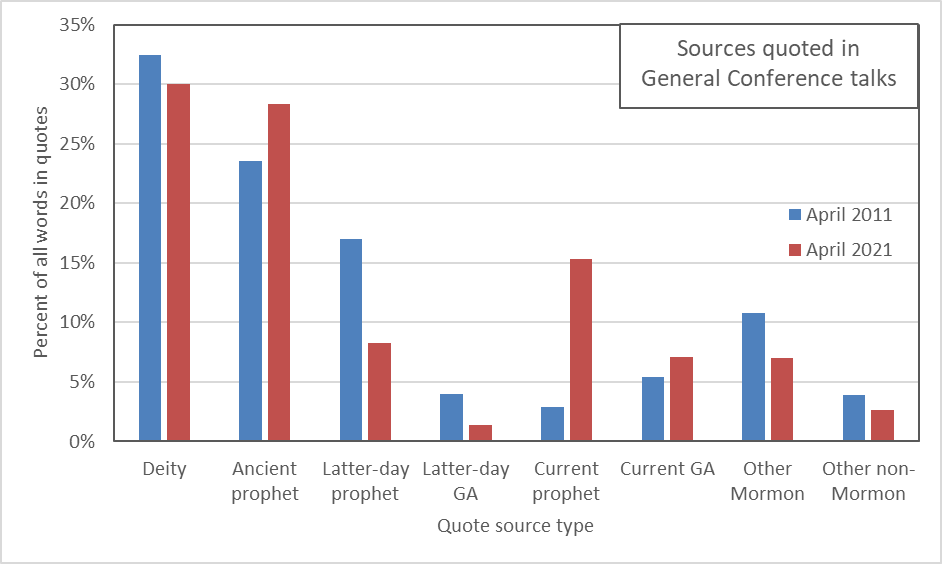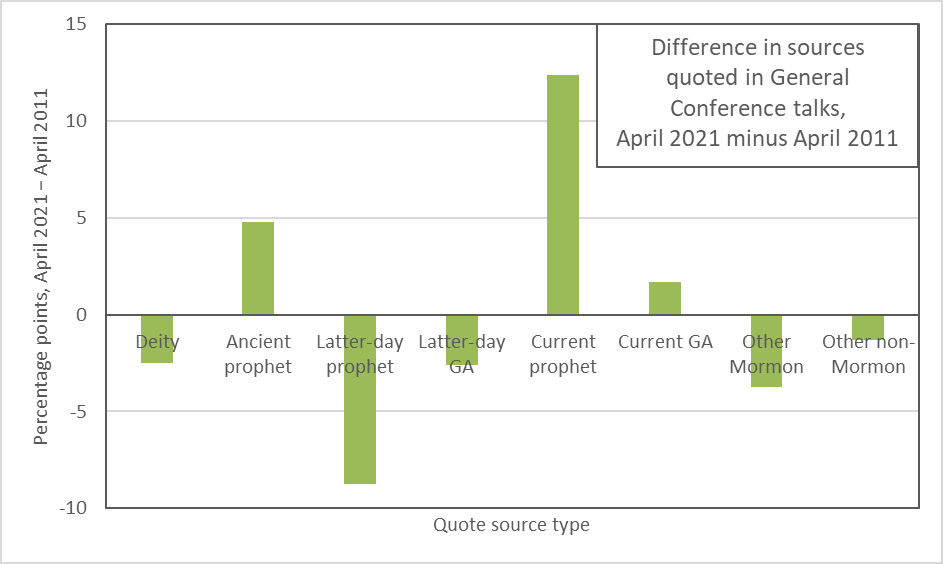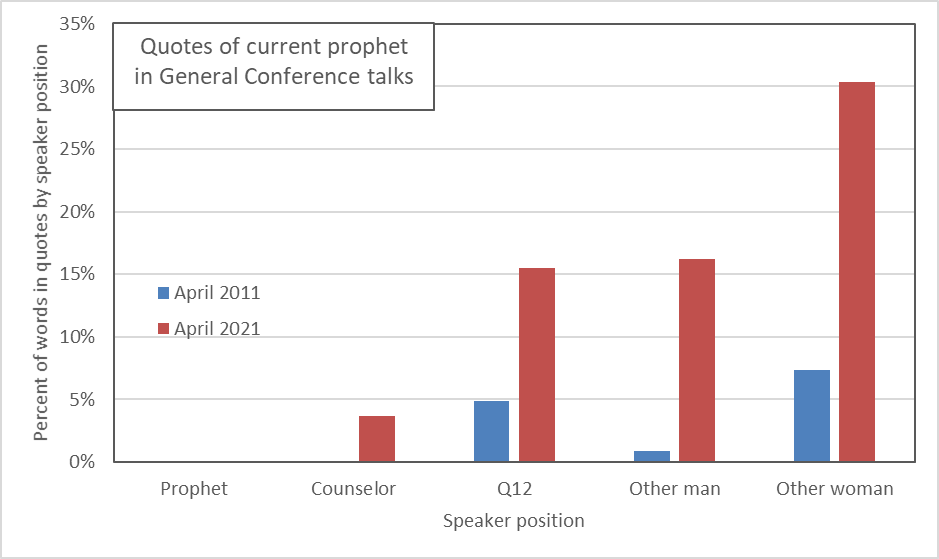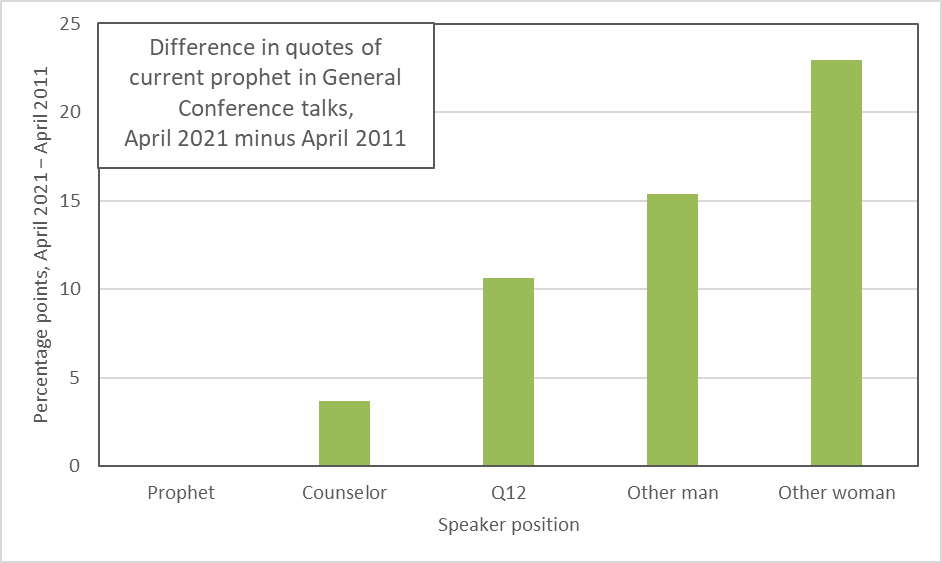Since President Nelson assumed office, I’ve read a number of discussions of how he seems to get quoted a lot in General Conference, even in comparison with previous Church Presidents. For example, it’s mentions of his name rather than quotes, but TheFingerLakesBandit posted a graph (presumably based on Corpus of LDS General Conference Talks data) on the Mormon Subreddit a few months ago that showed that President Nelson’s name has a much bigger spike than any other newly-called Church President since World War II or so. And this certainly matches my own experience: I feel like he’s quoted a ton.
When I was working on my Conference review post last month, I decided to note all the sources quoted so I could do a little comparison. I chose to compare this last Conference against April 2011. I chose it as a comparison point not because it was a decade ago, but because at that point, Thomas S. Monson had been Church President for about as long as Russell M. Nelson has been now (it was the seventh Conference as President for each of them).
For each quote in each talk, I noted the following:
- The speaker’s name and position
- The source of the quote
- The length of the quote in words
Of course there are many different sources quoted in Conference. The majority are from scriptures, but there are also lots of other Mormon and even occasionally non-Mormon sources. To make the data easier to look at, I sorted the quotes into the following categories by type of source:
- Deity (scriptures that are in the words of Jesus)
- Ancient prophet (most non-deity scriptures)
- Latter-day prophet (including some D&C verses in Joseph Smith’s voice instead of Jesus’s)
- Latter-day GA
- Current prophet
- Current GA
- Other Mormon
- Other non-Mormon (including occasional bits of scripture like Pharisees interrogating Jesus)
I excluded three types of quotes entirely:
- Sometimes a speaker quotes a source and then uses a phrase from that source repeatedly throughout their talk. For example, in her 2011 talk, Mary N. Cook quoted the song “Kindness Begins with Me.” Then, throughout the talk, she repeated the phrase “remember this: kindness begins with me” several more times (and once just “kindness begins with me”). I counted the first quote, but excluded the others.
- Sometimes a speaker quotes someone in the context of telling a story rather than because they’ve said a wise thing. When a quote was just used for the story, I excluded it, because I wanted to count only cases where someone is quoted for their wisdom. For example, in this 2011 talk, Quentin L. Cook told the story you might remember about a teen girl’s purse that was left at a dance, and how the people who found it inferred what kind of person she was based on its contents. In telling the story, he quoted from the stake YW President talking about the contents of the purse. I didn’t include this quote.
- Following the same principle as the previous point, if a speaker quoted something they thought listeners might be saying or thinking, I didn’t count that. For example, also in a 2011 talk, Dieter F. Uchtdorf supposed that people might be texting each other about his talk and saying “He’s been speaking for 10 minutes and still no aviation analogy!” As this wasn’t included in the talk because it shares a bit of wisdom, I excluded it.
The biggest difference between the two Conferences is that April 2011 had an extra session (General Young Women) because it was before women’s meetings were moved to Conference weekend and alternated with General Priesthood meeting. The number of talks was similar, though (37 in 2011, 35 in 2021), because the 2021 talks were generally shorter (an average of 1560 words versus 1820 in 2011). A similar fraction of the total words in talks were quotes, 15% in 2011 and 16% in 2021. Because of this, I did all the analyses below by looking at quotes of a particular source as a fraction of total quotes, rather than as a a fraction of total words. Also, to take into account different length of quotes, I used words in quotes as the unit of analysis (for example, counting a 20-word quote for twice as much as a 10-word quote) rather than individual quotes.
This first graph shows the percentage of quoted words coming from each of the eight source types, comparing April 2011 against April 2021. For example, the leftmost blue bar says that about 33% of words in quotes in April 2011 Conference were quotes of deity.

Because this just shows a breakdown of the full 100% into categories, the sum of all the blue bars is 100% and the sum of all the red bars is 100%. Between the two Conferences, the percentages only get shuffled around.
The comparison of interest is for “current prophet.” As I expected, there were far more words quoted from the current Church President in April 2021 than in April 2011. These went up from less than 5% of all quote words to over 15%. The increase is about a factor of five.
This next graph shows the differences in percentage points. That is, to get each green bar, I just subtracted the height of the blue bar from the height of the red bar in the graph above.

It looks like the change from April 2011 to April 2021 is mostly in fewer words quoted from latter-day prophets other than the current prophet and more words quoted from the current prophet.
I also thought it might be interesting to see if the increase in quoted words from the current Church President varied by the position of the speaker. I grouped speakers’ positions into the following categories:
- Prophet
- Counselor in First Presidency
- Quorum of the Twelve
- Other men (mostly Seventies)
- Other women (general Relief Society, Young Women, and Primary presidencies)
This breakdown of eight source types by five speaker positions by two Conferences makes for a lot of data points, most of which aren’t interesting, and only make a graph hard to look at. Therefore, I just pulled out quotes of the current prophet and that’s all that’s shown in the next two graphs.
This graph shows percentage of quote words that quote the current prophet, broken down by speaker position. Unlike the first graph above, because this graph doesn’t represent all quote words, the bars don’t add to 100%.

Not surprisingly, neither President Nelson nor President Monson quoted himself in the Conferences I was looking at. It’s interesting, though, how after that, the change appears to be larger as you move down the hierarchy. This looks like it’s the lower-status leaders who feel the greatest need to show their deference to President Nelson.
This last graph just converts the graph above into percentage point differences by subtracting the blue bar height from the red bar height.

One last question I had was whether the difference in quoting the current Church President was because more speakers were quoting him, or because those who were quoting him were using longer quotes. You can probably already guess the answer even if you’ve just listened to a little bit of Conference. It was far more because more speakers were quoting him. In April 2011, only 19% (7 of 37) talks quoted the current prophet; in April 2021, 49% (17 of 35) talks did. There was also an increase in quote length, but it was modest by comparison. In April 2011, speakers quoting the current prophet used 16% of their quote words quoting him; in April 2021, they used 23%.
It’s just a two-Conference sample, but the difference I found here is so large that it sure looks like it supports what we’ve all been thinking. President Nelson is getting quoted a lot more as Church President than President Monson did. Now that we’re a few years into President Nelson’s tenure too, it’s pretty clear that this isn’t a pattern he disapproves of or is going to move to stop.
Thanks for the numbers. They reinforce some thoughts I’ve had over the last year regarding this issue.
This is speculative, but I believe quoting the current President is an expression of, for want of a better term, “tribal loyalty.” This is especially true when the quotes could have been easily paraphrased or taught from the scriptures, without reference to the administrator at the top. When I see this type of behavior in other settings and institutions, I interpret it as evidence that there is conflict within an organization of personalities and ideas or perhaps some sense of instability. In such settings, the lower-level management often signals loyalty to the administration because their own prestige and jobs may be on the line. The speakers are trying to establish some sense of security. All of this makes real sense in a church setting because President Nelson has “stirred the pot” considerably during his tenure and there are issues arising which need to be addressed institutionally.
Ooh, that’s such an interesting theory, Old Man! I’m trying to think of what other pattern we might expect to see if it were true that I could maybe go looking for.
I wouldn’t have thought of that Old Man but it makes sense! I have wondered if President Nelson is somehow explicitly encouraging other speakers to reinforce his words but maybe it’s more an expression of underlying anxiety around current conflicts in the church. I believe there is definitely a sort of war going on around feminist and LGBTQ issues in the church at all levels and there are also a lot of concern about low retention of young adults. I could see these situations as feeding this behavior.
Are you counting the quoted person by their current calling or their calling at the time of the quote? When speakers quote the current president, how many of the quotations predate the person being the president?
I’m counting the position as of the time of the quote, not as of the time of the source. Sorry–I didn’t note the position at the time of the source. I didn’t think it was an interesting question, but perhaps it would be. But the calling at the time of the quote was what I was really interested in.
This kind of behaviour may be acceptable in American or even Utah culture, but just looks like a bunch of sycophants in the much of the world, and does nothing to enhance the credibility of the leader, the sycophants, or the organization.
Ziff It would be interesting to see a comparison of the number of “we love you pres ….’
Thanks, Ziff. I guess the terminology is a little ambiguous. When you say time of the quote, it sounds like you mean the time when the person was cited, not the time when the quote was spoken or written. So if somebody in 2021 quoted something Brother Nelson said in 1996, that counts as a quotation of the president of the church, and if in 2011, Brother Renland quoted someone in conference, that is counted as a quotation by an apostle?
My guess re: time of saying versus time of quoting would be that there would be little distinction — after all, a big chunk of each volume in the “Teachings of the Presidents of the Church” series came from before their presidencies! Howard W. Hunter’s would have been exceptionally short otherwise…
Sorry, Left Field, to not be clearer. By the time of the quote, I mean the time of the quoting the speaker is doing (i.e., always April 2011 or April 2021 for this sample), rather than the time the original words were written or said.
And interesting point, MH. I guess for Nelson and Monson, they would because of the times I chose, have exactly the same amount of time as Church President as of these Conferences. But of course Monson had more years as a Q12 member before ascending to the top spot than Nelson did because he (Monson) was called at such a young age.
In addition to the concepts of tribal loyalty and even of some being syncophants, I think there is also the possibility that speakers feel there is more of Pres. Nelson’s teaching that is groundbreaking and part of a new chapter for the church. The speakers may want to be part of that story. Pres. Nelson has emphasized that there is more to come, take your vitamins, and so forth. As an aside to that issue, we also have the often repeated new jargon of the “ongoing restoration.” That phrase seems to signal that more is coming and sometimes perhaps is code for us to be patient if there is something we don’t like.
If any of that holds water, is President Nelson therefore more quotable than some prior presidents? Are his teachings more direct and less like a long list of platitudes that have been heard before? Are there fewer stories that just recount when he was a boy? It’s interesting that when some get of a certain age, we just here more stories from them. President Monson likely had cognitive difficulties his last few years, so there may not have been much to quote that hadn’t been said before (he clearly recycled a few talks) or that anyone thought was actually a directive for the church.
That’s a really great point, Dub. It would be an interesting thing to see if I could see any pattern to it where those who quoted Nelson were quoting a wider variety of things.
Thanks, Ziff! Very interesting and makes me ponder as to the “why.”
My first reaction is similar to Dub’s: not only did Monson make fewer noteworthy changes to the Church during his tenure, Monson also seems to have made fewer “pronouncements.” Nelson, on the other hand, seems much more direct and pointed in his sayings. Maybe makes him more quotable.
Last, one overarching consideration: Nelson’s rhetoric indicates to me that he has more explicitly embraced his role as the prophet who speaks the mind and will of the Lord than did Monson. I don’t remember such overt references to receiving direct inspiration, etc. from Monson. Perhaps that factor increases the propensity to quote Nelson, too.
Ziff, Are you able to tell whether this behaviour, and we love you pres Nelson, changed when trump was in the whitehouse. He demanded obedience and loyalty. Perhaps the culture particularly among his followers carried over to their religious leader.
80% of members over 40 voted trump.
Great point about Nelson openly embracing his role as prophet in ways past Church Presidents haven’t, Hunter.
Sorry, Geoff, no. I only sampled this one pair of General Conferences, so Trump was already out by the time of the one I sampled for Nelson.
My thoughts echoed Dub’s. It could also be a case of organizational reps staying on message, possibly even at Nelson’s recommendation. Okay team, here are our key ideas to emphasize: keeping on the covenant path, “hear Him”, ongoing restoration, women having access to priesthood power but no priesthood (and probably a few other things I would know if I paid closer attention). I suspect a lot of the quotes have to do with those few main ideas Nelson is pushing. He presents the idea initially and then the the others are responsible to remind and hammer it in.
Last year at Sunstone I shared some text analysis of talks going back to 1942, and had a chart very similar to the one you got from Reddit. (The reason for 1942 is that full text of talks are available at scriptures.byu.edu going back that far, even though the church web site which only goes back to 1971. Going back any further is a whole lot more work, but something I would like to do one day). Typically there is a spike in mentions of the current president of the church in his first general conference, and then it reverts to a level that has stayed relatively constant for decades. Except, references to Nelson doubled when he took charge, and still have not abated 3+ years on. I don’t know what to make of it. I wonder whether this is conscious or not. Is there something in his personality that makes others feel they need to mention him more frequently? I like the theories proposed by others.
Also, I have looked at which of the current apostles are most likely to mention the current president of the church. Neil Andersen wins that one by a comfortable margin. Probably I should look at whether any particular apostle stepped up their talking about the president of the church. If any of them changed in 2018, that could tell us something about the interpersonal dynamics of the leadership.
Thanks for all the additional information, Quentin! A couple of conferences ago, in my review, I noted that Elder Andersen seemed to be awfully strong on the hagiography. It’s cool to have my anecdotal observation corroborated by actual data!